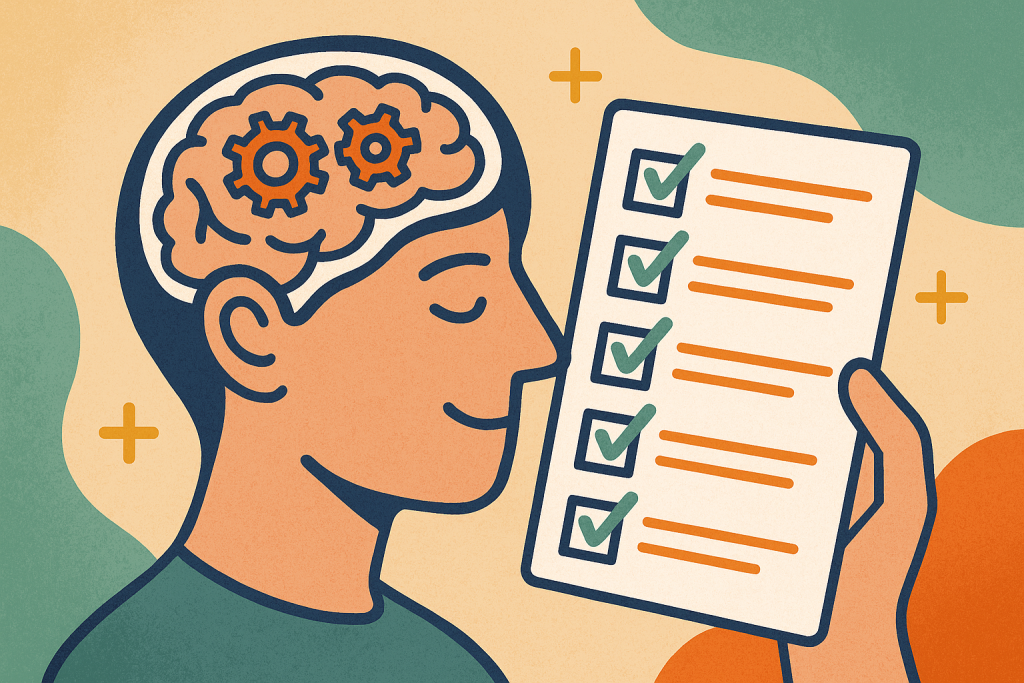Have you ever wondered why your brain loves lists? It comes down to reducing anxiety, boosting memory, and triggering feel-good dopamine. But when misused, lists can crowd your mind, spark stress, and lower creativity. Understanding when to rely on lists — and when to avoid them — can transform how you think, work, and feel.

Why Your Brain Loves Lists
1. They Calm Mental Chaos
Lists act like mental parking lots. By capturing tasks externally, they reduce cognitive load and clear mental clutter. Studies show that unloading tasks onto paper can significantly reduce anxiety and improve focus. A Psychology Today analysis confirms lists are therapeutic, lowering anxiety and even helping those with ADHD.
2. They Give Structure and Direction
Being human, we crave order. Lists offer a clear roadmap, turning ambiguity into a sequence of steps. Structured tasks are easier to process and remember — exactly what our memory systems prefer. According to Harvard Business Review, lists satisfy our craving for structure and progress tracking.
3. They Tap Into the Zeigarnik Effect
Our brains fixate on unfinished business. The well-known Zeigarnik effect, discovered in the 1920s, shows we remember incomplete tasks better than completed ones — which can be distracting or motivating. Incomplete tasks linger in our minds until we externalize them — making lists an effective way to reduce mental tension.
4. Each Checkmark Is a Dopamine Booster
Crossing off a task triggers dopamine release — the same neurotransmitter that motivates us and boosts mood. Workast explains how completing a to-do list can even restore motivation when energy is low.
5. They Boost Self-Worth
Seeing progress builds confidence. Finishing tasks, even small ones, boosts self-esteem and motivates more action.
When Lists Don’t Work (Even If You Love Them)
1. Long Lists Can Overwhelm
Paradoxically, too many items cause greater cognitive stress. Workers with overstuffed lists report feeling overwhelmed — not organized — making them less productive.
2. Lack of Prioritization Blurs Focus
A vague list like “do report” isn’t helpful. Without context, timeframes, or structure, items stay pending. Simply listing tasks isn’t enough — you need clarity .
3. They Can Reduce Flexibility
Rigid lists may stifle creativity and spontaneity. When everything needs checking, you lose emotional connection and space for adaptation or innovative thinking.
4. Mental Fatigue Sets In
Thinking about tasks releases stress hormones similar to actually doing them — even just seeing items on your list can tire your mind . In extreme cases, this anticipatory stress can impair working memory en.wikipedia.org.
How to Use Lists Smartly
Use these strategies to harness benefits while minimizing drawbacks.
Keep Lists Short: 5–7 Items
Cognitive load peaks around 7 ± 2 items. Keeping your list concise wards off overwhelm .
Break Big Tasks into Mini-Steps
Large, vague items paralyze. Use chunks: instead of “Write report,” break it into “Outline,” “Research,” “Draft,” and “Edit.”
Add Time & Priority Labels
Mark what gets done today, tomorrow, or is optional. Time estimation clarifies urgency.
Write “Done” Lists Too
Psychology Today recommends adding “done” lists to shift focus from pending stress to completed wins.
Use the Zeigarnik Effect Wisely
Start with just five minutes of effort to trigger completion momentum. This method takes advantage of the Zeigarnik effect and helps overcome procrastination.
Combine With Time Blocking
Pair your list with scheduled focus blocks. That organizes mental bandwidth and avoids distraction from multitasking.
Leave Room for Creativity
Block off “open slots” in your schedule for unstructured thought or creative exploration. This builds flexibility.
Review & Revise
Do a daily check-in. Remove obsolete items, reassign priorities, and celebrate wins. It keeps the list updated and functional.
When to Use Alternatives to Lists
Lists aren’t always best. Consider alternatives:
Checklists
Ideal for routine tasks like packing, grocery shopping, or preparation steps.
Time Blocking/Calendar
Best for tasks tied to deadlines or that require sustained focus — just make sure you assign real time in your calendar.
Mind Maps
Great for brainstorming or capturing non-linear ideas — gives freedom and visual structure.
Journals & “Done” Logs
Journaling what you’ve achieved helps track progress, emotional trends, and reflect on larger goals.
Putting It All Together: A Smart Daily Routine
Morning Start-up:
- Capture current thoughts/incomplete tasks (Zeigarnik offload).
- List no more than 7 tasks with priorities and time estimates.
- Include at least one “done list” item from yesterday for momentum.
Midday Check-In:
- Use your list to time-block midday tasks. Add at least one buffer/open slot.
Evening Review:
- Consolidate new incomplete tasks before winding down.
- Move unwritten thoughts to “done yesterday” and mark tomorrow’s list.
This structure guides focus, motivation, and reflection — while respecting mental limits.
Final Takeaways
- Your brain loves lists because they reduce anxiety, improve memory, and feel rewarding.
- But a poorly structured list can overwhelm, demotivate, and limit flexibility.
- Use why your brain loves lists as a guiding concept—coupled with limitations awareness—to shape your system.
- Rely on clarity, constraints, and reflection to ensure your lists serve your mind — not stress it.
By understanding both the power and pitfalls, you can craft a system that supports your productivity and mental wellbeing — on your terms.
References
New Yorker – “A List of Reasons Why Our Brains Love Lists”https://www.newyorker.com/tech/annals-of-technology/a-list-of-reasons-why-our-brains-love-lists
Psychology Today – “10 Benefits of Making Lists”https://www.psychologytoday.com/us/blog/defining-memories/202105/10-benefits-making-lists
Workast Blog – “The Secret Psychology on Why We Love Completing To‑do Lists”https://www.workast.com/blog/the-secret-psychology-on-why-we-love-completing-to-do-lists/






